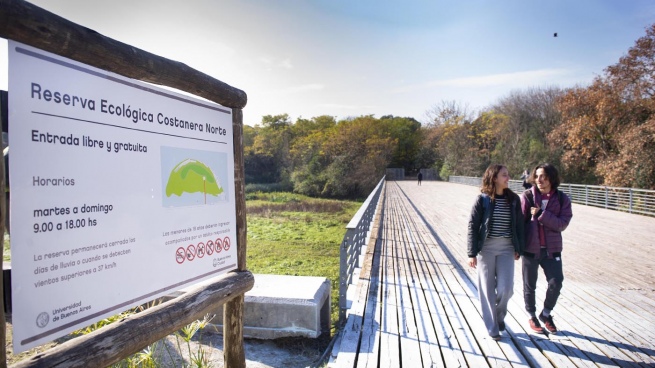The ecological reserve of Costanera Nortea space co-managed by the University of Buenos Aires and the Buenos Aires government, opened to the public after 10 years of its creation by law as a new green space alternative in the city of Buenos Aires to carry out days of walks, sightings and recreational activities and leisure on the banks of the River Plate.
It’s about the Ecological Reserve Ciudad Universitaria- Costanera Norte (Recucn)created by law in 2012 after three decades in which civil society fought for its defense, especially professionals and students from the UBA.
Thus, with the necessary infrastructure ready to receive visitors, the Costanera Norte joins the fabric of urban reserves of the City of Buenos Aires, among which are the Costanera Sur Ecological Reserve (350 hectares) and the Lake Lugano Reserve (with 36 hectares).
In a 23-hectare property with a clear view of the riverthis natural area has trails that can be explored on foot and by bicyclewhere you can see a significant sample of the region’s own biodiversity and do leisure and recreational activities during the day.
Can visit from Tuesday to Sunday from 9 a.m. to 6 p.m., with free admission and its entrance is behind Pavilion 3 of Ciudad Universitaria.
About this reserve, which is the first managed by the Buenos Aires government and the UBA, the rector of this institution, Alberto Barbieri, assured that it represents “a very valuable space for the university community”.
In this framework, he announced that, in accordance with what was agreed with the local government, “the necessary measures will be taken to maintain the environmental balance, the protection of flora and fauna, and the preservation of the natural, landscape and cultural heritage of the different areas”.
For her part, the Secretary of the Environment of Buenos Aires, Inés Gorbea, expressed her “pride” for the joint work with the UBA in the management of this green space which, together with the other reserves in the city, constitute “a fundamental biocorridor for biodiversity” of the territory.
“We celebrate that the neighbors can visit this ecological reserve that constitutes a valuable space to guarantee the biodiversity in the scope of the City”, he added.
During a tour of the property, Germán Ausina, operational manager of the ecological reserves and conservation areas, highlighted in dialogue with Télam the importance of “promoting the care of these great lungs that society has, spaces that help improve the quality of life of all the inhabitants of the city”.
In that sense, he stressed that having a reserve in the area allows not only direct contact with nature but also the containment of river floods and contributes to the mitigation of noise and visual pollution of the city.
“At the end of 2018, civil society, NGOs, the Faculty of Exact Sciences and national parks were convened, and together we developed a management plan where the work to be done for the next 10 years is projected, which It is our guiding framework for the development and conservation of this area,” explained Ausina.
With a landscape dyed in autumn colors, The reserve has different ecoregions such as grasslands, forests and wetlands, where a mixture of autochthonous, native and exotic flora and fauna species coexist..
Mushrooms, ferns, dicotyledons and monocotyledons are some of the plants that nourish the area, along with the talar orchid, the anacahuita, the molle, the white carob tree, the curtain of the sky and the cat’s claw, among others.
Y more than 600 species of animals were recorded on the property, including birds, fish, reptiles, amphibians and mammalslike coypu.
Even without being officially inaugurated, on weekends around 500 people visit the reserve, where views of the free horizon can be seen, framed by the towns of Quilmes and Vicente López on each side.
Attracted by the tranquility and almost uninterrupted silence, a large number of students from the Faculties of Architecture, Design and Urbanism and Exact and Natural Sciences visit the reserve every day to eat, study or rest between classes.
Likewise, due to its proximity to the study houses, this area is used by teachers with educational and research objectives, which makes it an “ideal space” for carrying out practical work, seminars and research projects.
Within the framework of World Environment Day, which is commemorated this Sunday, the authorities emphasized spreading the Costanera Norte reserve and inviting “to know this space of use and enjoyment of all citizens not only of the Federal Capital but of all the people of the country.”


















